► Limited run of four two-seat roadsters
► All-new chassis and advanced aerodynamics
► Second of four Droptails revealed
Short version: you’ve seen the red one, now here’s the blue one. To elaborate, this is the new Rolls-Royce Amethyst Droptail, the second of four Droptails that will be crafted by the Coachbuild department in Goodwood, created in close liaison with its ultra-wealthy buyer.
Like the recently revealed La Rose Noire Droptail detailed below, the Amethyst is a two-seat, two-door roadster using a hotted-up version of Goodwood’s V12 engine in a special low-riding steel, carbonfibre and aluminium chassis, and it has a removable hardtop.
What’s different about the Amethyst Droptail?
There’s even more wood than La Rose Noire. So much so that the wooden panel behind the seats actually contributes downforce, claimed to be unique in the car world.
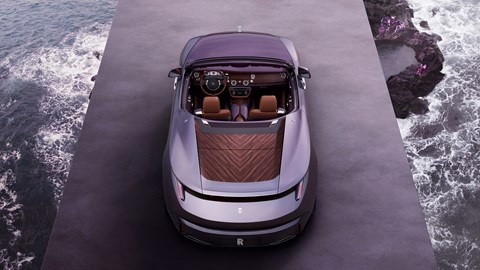
The floormats are woven leather, a nod to the traditional crafts of the owner’s original home region, before their gemstone business took off and they joined the global elite.
The instrument dial surrounds use amethyst cabochons, meaning gemstones that have been shaped and polished into a round rather than faceted shape, reducing the sparkle. The same treatment can be seen around the feet of the Spirit of Ecstasy figurine on the bonnet.
Anything else outside?
The lower air intake incorporates 202 hand-polished stainless-steel ingots, hand-painted. The grille is a first for Rolls in having two finishes simultaneously, inspired by the part-brushed, part-polished hands of the owner’s son’s favoured Vacheron Constantin timepiece.
The 22-inch wheels are highly polished on the outside, but in certain lights you can just about make out a hint of mauve – a nod to the owner’s favourite jacket’s lairy lining.
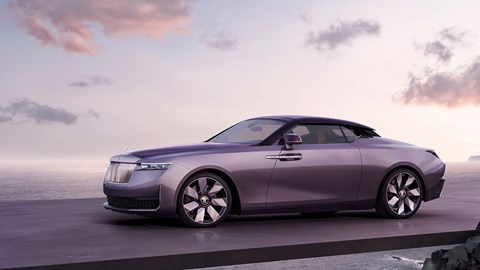
Similarly, the carbonfibre at the bottom of the car’s back end has a bespoke chevron pattern and a fine layer of lacquer that echoes the bodywork’s dominant colour.
That paint is inspired by the globe amaranth wildflower, which blooms in the desert near one of the owner’s homes. We might call it blue, but keen eyes will spot that it’s a soft purple with delicate silver undertones and flecks of powdered aluminium, contrasting with a deeper purple used higher up on the car.
Just a rich person’s folly?
Maybe, but Rolls-Royce made sure it’s fit for driving anywhere in the world. Accordingly the exposed wood and leather interior has been tested to the same rigorous standards as the exterior, including extreme hot and cold conditions, for more than 8000 hours. The protective coating used on the wooden deck has its own patent, so don’t go looking for it on the Ronseal website.
Read on to find out more about the first in the series of four: the Droptail La Rose Noire, the red car pictured below. It was unveiled at Monterey Car Week 2023.
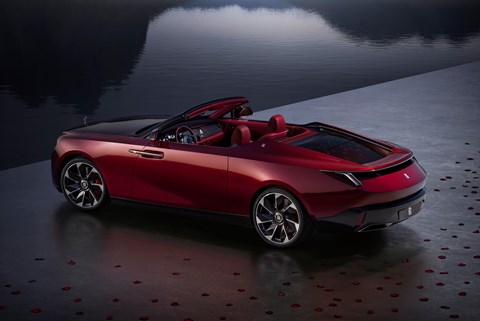
The first Rolls-Royce Droptail La Rose Noire
Ignore, if you can, the onboard carbonfibre champagne store. Look past the one-off Audemars Piguet timepiece that can be installed in the dash or worn on the wrist. Try not to be distracted by the sanity-challenging intricacy of the finishing process devised especially for this car. Instead, focus on the mechanicals. Because here is that rarest of Rolls-Royces: a two-seat roadster with an innovative chassis not shared with any other model.
The Droptail, developed over more than four years, is the latest in the glacial trickle of one-off and few-off models built under the Rolls-Royce Coachbuild scheme. You might remember the dazzling Sweptail two-door coupe of 2017 and 2021’s strongly nautical open-top Boat Tail. They are designed and built in collaboration with a select few of Rolls-Royce’s most loyal and most wealthy customers. Down to the smallest detail, they are shaped, equipped and finished in a process that’s more like creating a sculpture park in the grounds of a country estate than sending another Vauxhall Astra down the production line.
The body
Since Rolls-Royce’s Goodwood era began 20 years ago under BMW ownership, the focus has been on four- and five-seaters. And indeed for most of its history since the company was established in 1904, European buyers have wanted roomy limos, often chauffeur-driven. But for more than 100 years there has also been, in tandem with that, a tradition of US buyers commissioning two-seat, two-door roadster bodies for their Rolls rolling chassis.
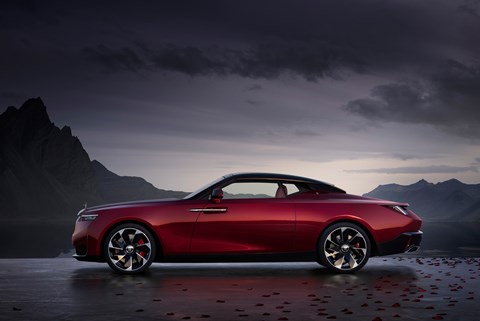
Some of those cars were studied by Goodwood’s Coachbuild team, including the 1912 Sluggard, the 1925 Silver Ghost Piccadilly and the 1930 Phantom Brewster.
Droptail is 5.3 metres long and 2.0 metres wide, relatively compact for a Rolls-Royce. It has a low profile, taut surfacing and snug cabin. Behind the seats are ‘sail cowls’, resembling the jib of a yacht.
The shaping of the bodywork is not purely cosmetic. It also produces downforce to improve stability at speed – an effect difficult to achieve with a dropping rear end. How difficult? It took the designers and aerodynamicists two years of to and fro, and 20 versions.
At the back, the horizontal ‘transom’ section, inspired by ’30s yachts, uses natural light to visually reinforce the car’s sturdiness. The rear lights are angled forwards, while the rear diffuser is exposed carbonfirbe.
The grille and the badge are both revised. The vertical vanes of the grille are for the first time kinked near the top. This creates a shadow that visually links the headlamps.
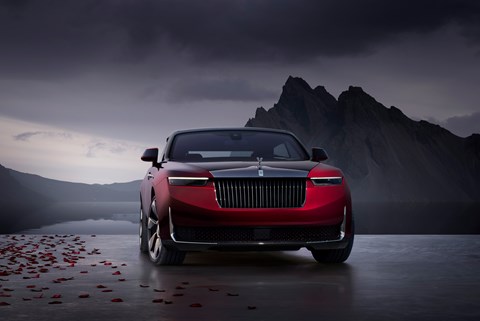
Coachbuild boss Alex Innes emphasises that the end result is progressive and clean: ‘Droptail is a celebration of reduction and focus of purpose that is entirely in tune with contemporary codes of luxury.’
The roof is a removable carbonfibre hardtop, transforming the profile from roadster to coupe, with a hint of hot rod in its proportions. It incorporates electrochromic glass that can filter out bright sunlight at the touch of a button.
The chassis
Design chief Anders Warming insists: ‘Droptail, the most involved, progressive and refined Coachbuild to date, is not a concept car or a design study – it is a motor car that has been built to be driven.’
It breaks with Goodwood tradition by not using a version of the aluminium spaceframe employed in all current production Rolls-Royces. Instead, there is a new monocoque made from steel, carbonfibre and aluminium. The load-bearing front wing and doors are steel, while the bodywork from the B-pillar back is formed from three bonded carbonfibre sections.
The engine is a version of the familiar 6.75-litre V12, here dialled up to 593bhp and 620lb ft.
The colour
The red car you see here is the first of the four Droptails. It’s been commissioned by – and developed with – a super-rich couple with longstanding Rolls-Royce connections, who were due to be presented with the car at a private event close to the Monterey Car Week show at Pebble Beach in California. It’s called La Rose Noire, and takes its colour palette from the Black Baccara rose.
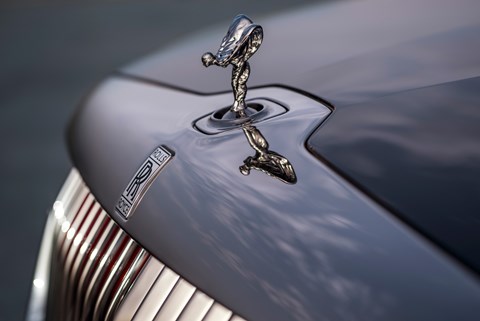
The thing about the Black Baccara is that its petals look almost black in the shade but become shimmering red in direct light. So the challenge for Rolls was to make the car appear to change colour when viewed from different angles.
The paintwork took 150 versions to get right. The main bodywork is finished in a special red, but underlying it is a secret base coat, then five layers of clear lacquer, each blended with slightly different shades of red.
A darker hue is applied to the body’s details. They’re not painted but electro-plated in layers one micron thick. The same treatment is applied to some of the interior. That darker colour is also used on the 22-inch alloy wheels.
The interior
The idea is cocooning and minimalist, with three prominent buttons (but the same functionality as any other 2023 Rolls). The facia took four years of work.
Wood looms large, showcasing cabinet-making skills, especially the ‘shawl panel’, which wraps around the occupants.
The cantilevered central armrest slides backwards to reveal the iDrive-style rotary controller.
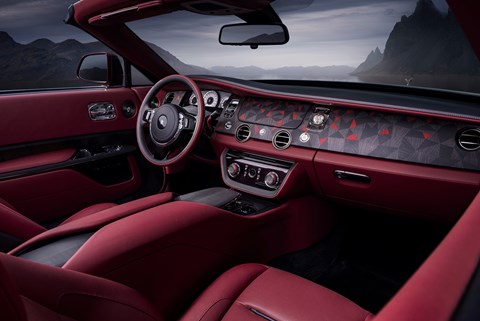
There’s a built-in artwork – spanning the shawl panel, the doors and the facia – that’s an abstract expression of falling rose petals. It was made using 1603 pieces of black-veneer wood triangles, 1070 forming the background, 533 representing the petals. Each piece is cut, sanded and positioned by hand. The red pieces are painted, while the darker pieces are shaded with various veneers. A lacquer, which took more than a year to develop, should stop it all fading.
The interior artwork required such concentration, according to Rolls-Royce, that one person could work on it for a maximum of five hours a day, one hour at a time. This included weeks working in complete silence in a soundproofed space. That all took nine months.
The timepiece is a one-off from Audemars Piguet. Specifically a 43mm Royal Oak Concept Split-Seconds Chronograph GMT Large Date with a unique self-winding Calibre 4407 movement, with a flyback chronograph and split-seconds mechanism.
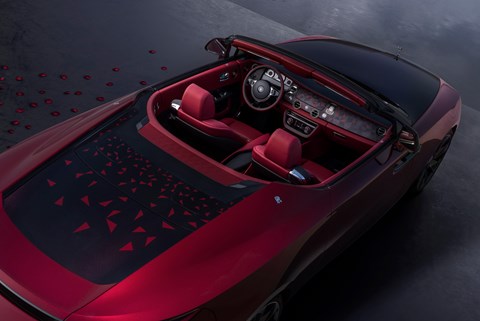
A powered clasp mechanism holds it in place on the dash, or at the touch of a button it can be released and worn on a strap. What, they couldn’t afford to buy two? When the timepiece is not in the car, the gap is filled by a coin hand-engraved by Audemars Piguet.
The car’s owners commissioned their own vintage of Champagne de Lossy. To house it in the car there’s a champagne chest with hand-blown flutes, and an exterior lid that doubles as a serving tray. The bottles are cradled in hammocks, and carbonfibre and aluminium coolers optimise the temperature.
What happens next?
There will be two more Droptails after La Rose Noire and Amethyst. Expect the same general shape and mechanical underpinnings, but many detail differences.
Rolls-Royce is on a path to an EV-only line-up by the end of 2030, so don’t expect a production version of the Droptail. But lose the V12, replace it with an electric powertrain, and it’s conceivable that a two-seat roadster could become part of the Rolls line-up of the 2030s or beyond. And you can be certain that everything Goodwood has learned about aerodynamics, chassis fabrication and exquisite finishing will be fed into its ever-growing database of options available to future Coachbuild customers.